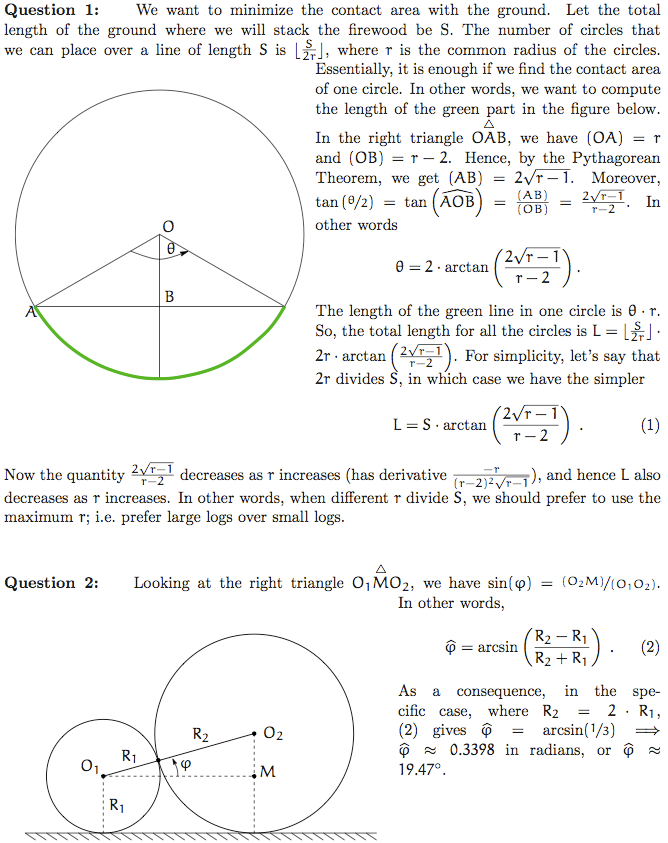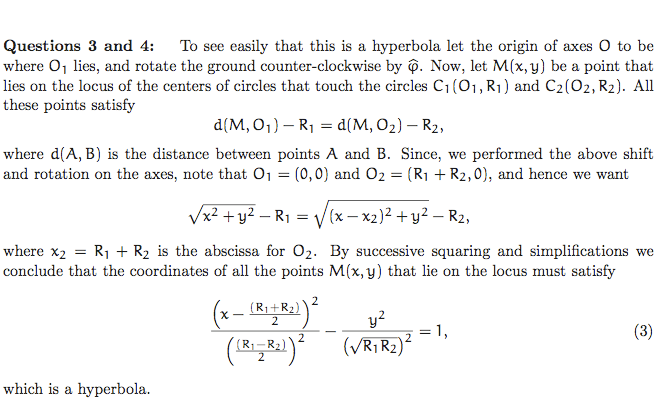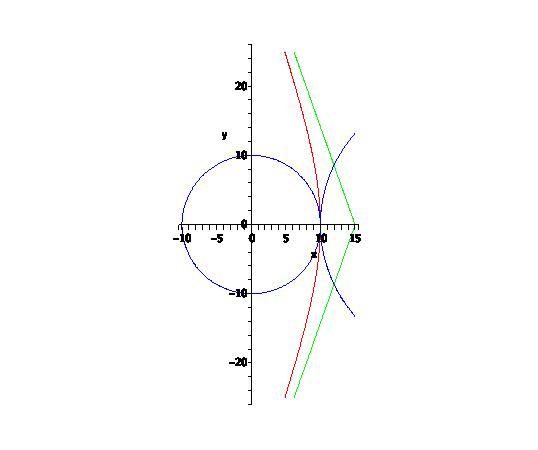|
|
AlexSpl

   
    
Responsible
Supreme Hero
|
 posted September 06, 2010 08:38 AM
posted September 06, 2010 08:38 AM |
|
|
|
I know only one function which satisfies f'(x) = gf(x). It's exp(x).
|
|
ihor

 
    
Supreme Hero
Accidental Hero
|
 posted September 06, 2010 08:47 AM
posted September 06, 2010 08:47 AM |
|
Edited by ihor at 08:50, 06 Sep 2010.
|
(ln f(x))' = 1/f(x) * f'(x) = g
Since the derivative of function ln f(x) is constant, the graph of this function will be line.
ln f(x) = g*x + c
Edit: Hmm, but how can ln f(x) be negative...
|
|
alcibiades

    
      
Honorable
Undefeatable Hero
of Gold Dragons
|
 posted September 06, 2010 09:35 AM
posted September 06, 2010 09:35 AM |
|
|
Quote:
I know only one function which satisfies f'(x) = gf(x). It's exp(x).
Wouldn't that pretty much be the answer, except you forgot a g:
f'(x)/f(x) = g <=> f'(x) = g*f(x) (f(x) =/= 0) => f(x) = C*exp(g*x) + C'
Now if C' = 0 it's fairly straight-forward, namely:
f(x) = C*exp(g*x) <=> ln(f(x)) = g*x + ln(C)
i.e. ln(f(x)) will be a straight line, with intercept ln(C) and slope g.
If C' =/= 0 it will not be quite as simple. However, as x -> infinity, C' << C*exp(g*x), which means that f(x) ~ C*exp(g*x) as x -> infinity. So ln(f) will approach g*x asymptotically (is that the right word in english?).
At x = 0, C*exp(g*x) = C, which means f(x) = C + C', which means ln(f) intercepts at ln(C + C').
As x -> negative infinity, exp(g*x) -> 0, which means f(x) -> C', which means ln(f) -> ln(C').
Not sure if I'm completely off the wrong line here, but that's how I'd solve it. So you'd have a graph that approaches constant (ln(C') at negative infinity and approaches straight line g*x + ln(C) at positive infinity, and intercepts y-axis at ln(C + C').
____________
What will happen now?
|
|
Ecoris

  
    
Promising
Supreme Hero
|
 posted September 06, 2010 11:44 AM
posted September 06, 2010 11:44 AM |
|
|
But Alcibiades, the function f(x) = C*exp(g*x) + C' only satisfies the differential equation f'(x) = g f(x) when C' = 0.
____________
|
|
alcibiades

    
      
Honorable
Undefeatable Hero
of Gold Dragons
|
 posted September 06, 2010 12:07 PM
posted September 06, 2010 12:07 PM |
|
|
Oh right, silly me, my mistake. 
____________
What will happen now?
|
|
mamgaeater

 
     
Legendary Hero
Shroud, Flying, Trample, Haste
|
 posted September 08, 2010 03:43 AM
posted September 08, 2010 03:43 AM |
|
|
The value of e...
It was briefly mentioned in calculus (its set for next week) but given what i know about it (it has a specific relationship with integers) i wanted to see if i could derive it.
After some head scratching i came up with this guess
e = n/n! where n is all positive integers. the problem is given i don't know quite enough about math (hence why i study it)... is this assumption at least somewhat on track?
1/1 + 2/2! + 3/3! and etc.
____________
Protection From Everything.
dota
|
|
ihor

 
    
Supreme Hero
Accidental Hero
|
 posted September 08, 2010 07:58 AM
posted September 08, 2010 07:58 AM |
|
Edited by ihor at 08:00, 08 Sep 2010.
|
This formula is correct, though usually it is written as follows:
e = Sum(1/k!), k=0..infinity
You can check it by using Taylor's formula for exponential function exp(x) in the point x=1.
e = exp(1) = exp(0) + 1*exp'(0)/1! + 1*exp"(0)/2! + ... = 1 + 1/1! + 1/2! + ...
|
|
ihor

 
    
Supreme Hero
Accidental Hero
|
 posted September 11, 2010 09:44 AM
posted September 11, 2010 09:44 AM |
|
|
Bugs' Love
Okay guys, new interesting puzzle:
You have square with edge length equal to 1. There are 4 bugs in all vertices of the square (bug 1, bug 2, bug 3, bug 4). Neighbour bugs are of different sex and it is said 1 loves 2, 2 loves 3, 3 loves 4 and 4 loves 1.
At the same time and with the same constant speed they all start moving in the direction to the bug each love. Obviously they'll meet in the center of the square.
What is the distance each of them will pass before the meeting?
|
|
dimis

   
    
Responsible
Supreme Hero
Digitally signed by FoG
|
 posted October 04, 2010 04:07 AM
posted October 04, 2010 04:07 AM |
|
Edited by dimis at 06:32, 04 Oct 2010.
|
Stacking Firewood
Binabik, thanks for the problem. It is a very interesting one;  Math-QP applied. Math-QP applied.
However I hate you since you didn't draw the figures! 


The following picture shows with the red line the requested locus when the radii are 10 and 20 cms. The green lines show the asymptotes.

From the above it should easily follow (with calculations) what is the maximum radius/diameter for a circle that lies in M, so that it remains in place without rolling off. These calculations - don't forget the rotation! - are yours.
As Corribus said, the problem has long history. Nowadays it is essentially part of Computational Geometry. Binabik's version is a generalization of the Voronoi diagram (Wikipedia entry); i.e. weighted Voronoi diagram (Wikipedia entry). Essentially a Voronoi diagram partitions the plane in cells. Now pick any point in the plane (different from the original vertices). The cell where this point lies has the property that the closest vertex to our point is the only vertex contained in that cell. The dual diagram of a Voronoi diagram is the Delaunay triangulation (Wikipedia entry).
Moreover, a generalization of the above, is the Voronoi diagram of ellipses. Although these problems are old, there is still active work in that area. An ex-officemate and friend works on these; see for example his samples for the more general case of ellipses (instead of circles). Unfortunately, his thesis (available in his site) is in greek, but it has many cool figures. Also, have a look in CGAL which is developed primarily at INRIA (France); George is responsible for this part.
Finally, last month I bumped into Farey Sequences (Wikipedia entry) and the closely related Ford Circles (Wikipedia entry).
Oh, Apollonian Awesomeness. Even more!
____________
The empty set
|
|
dimis

   
    
Responsible
Supreme Hero
Digitally signed by FoG
|
 posted October 04, 2010 06:23 AM
posted October 04, 2010 06:23 AM |
|
|
Ok, let's give one more week or so for the problem by ihor (Bug's Love). I am interested in the solutions there.
____________
The empty set
|
|
ihor

 
    
Supreme Hero
Accidental Hero
|
 posted October 04, 2010 08:28 AM
posted October 04, 2010 08:28 AM |
|
|
For now I'd just like to post very interesting logical game, made on Flash by my very good friend.
I spent maybe 2 hours to finish all 25 rounds.
Have fun.
Cheat Death
|
|
Ecoris

  
    
Promising
Supreme Hero
|
 posted October 04, 2010 01:08 PM
posted October 04, 2010 01:08 PM |
|
|
|
ihor

 
    
Supreme Hero
Accidental Hero
|
 posted October 04, 2010 05:29 PM
posted October 04, 2010 05:29 PM |
|
|
Nope, the edge length is 1. So the diagonal length is equal to sqrt(2), and therefore half of the diagonal is sqrt(2)/2 = 1/sqrt(2).
So your answer would mean the bugs will move straightforwardly to the center, which is not correct. There will be curve...
|
|
Ecoris

  
    
Promising
Supreme Hero
|
 posted October 04, 2010 09:11 PM
posted October 04, 2010 09:11 PM |
|
Edited by Ecoris at 21:12, 04 Oct 2010.
|
Oh yes. I had divided the result I got from integration by the wrong factor (2 instead of sqrt(2)).
The correct result should be 1.
Very nice problem btw,  . .
____________
|
|
dimis

   
    
Responsible
Supreme Hero
Digitally signed by FoG
|
 posted October 05, 2010 12:11 AM
posted October 05, 2010 12:11 AM |
|
|
|
Binabik

   
     
Responsible
Legendary Hero
|
 posted October 05, 2010 12:24 AM
posted October 05, 2010 12:24 AM |
|
|
So when we go off topic we are on an arc tangent?
A distance of 1 for Ihor's problem? Not sure if I agree with that. That assumes that for every increment of travel, the bug gets that same increment closer to it's destination.
One problem with that problem is that it self references. The movement of A ultimately depends on the movement of A. So the path of travel for bug A can not be determined until the path of A is determined. It's like a cat chasing it's tail in ever decreasing circles.
|
|
dimis

   
    
Responsible
Supreme Hero
Digitally signed by FoG
|
 posted October 05, 2010 12:33 AM
posted October 05, 2010 12:33 AM |
|
Edited by dimis at 01:00, 05 Oct 2010.
|
That bugged me for a while, until I started guessing the "correct" route. My first attempts where failures, but then, I simplified my approach, and tried to actually draw a picture of the route ... I thought this was a desperate approach, but I think, that only then did I actually see some obvious things on the problem  . .
By the way ihor, this is a remarkable problem! Math-QP  applied of course! applied of course!
____________
The empty set
|
|
Binabik

   
     
Responsible
Legendary Hero
|
 posted October 05, 2010 01:00 AM
posted October 05, 2010 01:00 AM |
|
|
Yea, I needed to draw some pictures which I didn't do yet.
Several days ago I started to write this up from several different logical approaches. With some approaches my brain had a divide by zero error...or something like that. My first reaction was to picture a spiral (decreasing radius). My next reaction was that the length was infinite. Then I looked at how the bugs start and that's when I had divide by zero errors.
The side of the box should be a tangent to the curve. And the direction of travel at any instantaneous point in time is a tangent to the curve. i.e. the derivative of the function. But what function? The function self references.
I also viewed it as squares. At any point in time the bugs will form the four corners of a square. All squares will exist, with sides of 0-1 unit. So at some point the square with sides of 1/2 will exist. And a square with sides of 1/4 will exits, etc. I haven't crunched the numbers yet, but I was thinking that I could extrapolate the total length of travel from this.
The question is, with respect to time, will the square with sides of 1/2 unit be half the total time? Ecoris' answer would imply that this is true? This would also imply that the path is circular and not some other type of curve? Hmmmm.
OK OK, I really should draw it. But it's almost more fun without drawing it.
Of course there is always the question "What if the bugs hate each other and move away instead of toward each other?" If they are moving at the same speed, will they be 2 units apart in the same time as it took them to meet in the original problem?
|
|
ihor

 
    
Supreme Hero
Accidental Hero
|
 posted October 05, 2010 08:53 AM
posted October 05, 2010 08:53 AM |
|
|
 thx dimis. thx dimis.
As for the puzzle, to leave time for Bin, I won't say anything now, except from Ecoris's answer is correct. You may post your integration solution later. 
|
|
ihor

 
    
Supreme Hero
Accidental Hero
|
 posted October 21, 2010 08:27 AM
posted October 21, 2010 08:27 AM |
|
|
Okay, I think Ecoris may post a solution and we should move next.
There are still many interesting puzzles somewhere in my head . .
|
|
|
|





